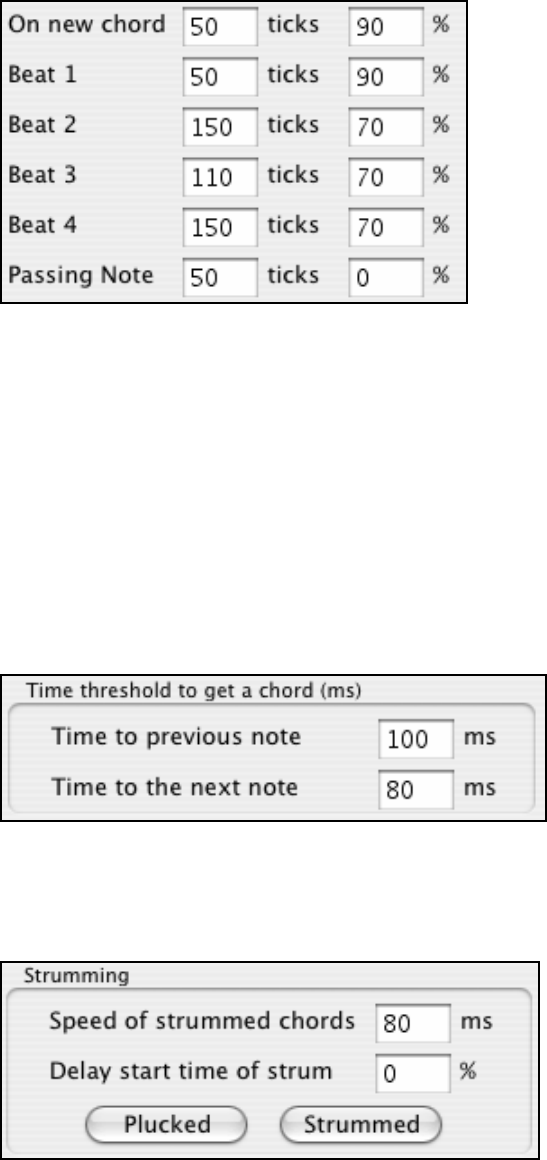User Guide
Table Of Contents
- PG Music Inc. License Agreement
- Table of Contents
- Chapter 1: Welcome to Band-in-a-Box!
- Chapter 2: QuickStart Tutorial
- Chapter 3: Band-in-a-Box 2010.5 for Macintosh
- Welcome to Band-in-a-Box 2010.5
- New Features in Band-in-a-Box 2010
- More New RealTracks
- QuickStart Tutorial
- Quick Song Settings
- Save Default Mix
- Improved Audio Rendering
- DAW Plug-in Mode
- Freeze Tracks
- RealTracks Enhancements
- New Favorite Songs/Styles Dialog
- Rendering Tracks
- StylePicker Enhancements
- New in the StyleMaker
- Chapter 4: The Main Screen
- Chapter 5: Guided Tour of Band-in-a-Box
- Chapter 6: Band-in-a-Box PowerGuide
- RealTracks
- RealDrums
- Song Settings
- The Chordsheet
- Chord Preview/Builder
- MIDI file “Chord Wizard”
- Applying Styles
- The StylePicker
- Playing, Pausing, and Stopping Songs
- Changing Volume, Panning, Reverb, Chorus, Bank
- Freeze Tracks
- Saving Songs
- Preferences – User Settings
-
- Show Chords with push/rest chars
- Metronome During Recording
- Harmony Volume Adjust
- OK to Load Style with songs
- Write Guitar part on 6 channels
- Turn External Keyboard’s Local On at end of session
- OK to beep with messages
- OK to prompt to reduce/expand
- For Roman Numerals in minor keys, use relative major
- Save Button on main screen works as Save As
- Name MIDI files with .MID extension
- Allow larger fonts on Chordsheet
- Color for Chordsheet Area
-
- Other Editing Features
- MIDI Setup
- The JukeBox
- Chapter 7: Notation and Printing
- Chapter 8: Automatic Music Features
- Chapter 9: Recording Tracks
- Chapter 10: Audio Features
- Chapter 11: Wizards, Tutors, and Fun
- Chapter 12: User Programmable Functions
- Chapter 13: CoreMIDI and Apple DLS Synth
- Chapter 14: Reference
- PG Music Inc.
- Index
- Registration Form

Chapter 12: User Programmable Functions
250
you want a “forced open position,” you should likely transpose the melody to a lower octave prior to generating
the solo.
The settings for Note duration thresholds to get a chord refer to the length that a note must be before a chord will be
generated.
Looking at the settings above (for Guitarist #2), these would be interpreted as follows:
- If a note occurs and it is the “First Note of a New Chord,” and the note is not followed by another note for at
least 50 ticks (120 ticks = 1 quarter note), then a chord will get voiced 90% of the time.
- If a note occurs (not the first note of a chord), that is on “Beat 1 of a bar,” and the note is not followed by
another note for at least 50 ticks (120 ticks = 1 quarter note), then a chord will get voiced 90% of the time.
- Similar interpretations for notes occurring on “Beat 2, 3, and 4.” You can see that the threshold is higher for
notes on beat 2 and 4, which is how a guitar player makes chord solos.
- “Passing notes” are defined as short duration notes that aren't on the beat, and are followed by a note that is on
the beat. In the example above, passing notes will never be voiced as chords, since the tick threshold is set to
zero.
There is a further threshold applied to whether or not a note is voiced to a chord. These are durations in
milliseconds.
In the settings as illustrated, if the note occurs less than 100ms after the previous note, the note will not be voiced as
a chord. If the note is followed by another note within 80ms, then the note will not be voiced as a chord.
Strumming Settings
If the Guitar Chord were all played at the same time, it would sound as if it was “plucked.” Guitar playing is more
typically a strum.
Strum Speed: If you set the Speed of the strum to, say, 80ms, then the guitar chord will be “strummed” over a
period of 80ms.










